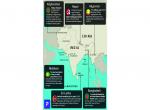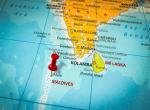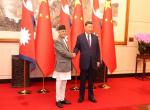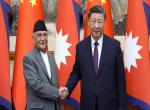Introduction
Afghan President Karzai during a visit to the Helmand province on 12 March continued, from the week before, his criticism of the US/NATO intentions in Afghanistan. He made a pointed reference to the US, claiming that it was ‘eyeing’ Afghan minerals and warned that Afghan government is aware of their intent. "Americans have asked Afghans to give them Afghanistan's mining contracts … from the start they have been doing their investigations and finishing their photography. But now they understand that we know about them".1
Karzai’s assertion may be high on rhetoric and less on substance as US commercial interests in the Afghan mining sector are, at present, far and few. However, developments in the Afghan mining sector match the hectic pace of events in the country’s surcharged political space. It is not Afghanistan’s immense mineral riches that are causing the excitement, but how the mining sector is being looked at in the present circumstances. An entire range of stakeholders see Afghanistan’s mineral deposits as a panacea for the country’s current problems. Mining, as the prospects of large international aid packages are dim, is the quick fire solution to secure finances to pay for country’s armed forces, draw investors, build infrastructure, create jobs, bring in industrial growth and development and alleviate poverty. The Afghan Ministry of Mines has identified 1,400 mines in different parts of the country and it is expected that the income from the mining sector will reach over US $1.5 billion to cover nearly half of the government’s budget by 2016.
The Afghan government concurs with the joint assessment of the Pentagon, the US Geological Survey (USGS) and USAID, that Afghanistan possess “previously unknown” and untapped mineral reserves including huge veins of iron, copper, cobalt, gold and critical industrial metals like lithium with an estimated worth of one trillion dollars. One estimate details this as Iron: $421bn, Copper: $274bn and Gold: $25bn besides other rare earths and minerals. According to some analysts the likely royalties and taxes that could be generated in Afghanistan could reach $3 trillion.2 The World Bank estimates that if the situation stabilises mining and agriculture together could raise annual growth rates by 3 to 4 percentage points between now and 2025.
It is true that the US, as was the case with the Soviet Union before it, has extensively mapped and estimated Afghanistan’s mineral deposits. Detailed Soviet exploration had produced excellent geological maps and reports that listed more than 1,400 mineral deposits, including about 70 of which are commercially viable. The Soviet Union subsequently committed more than $650 million for resource exploration and development in Afghanistan, and the proposed projects included a smelting complex for the Aynak mines that was to produce 1.5 million tons of copper per year.
Afghanistan has become the first country whose surface minerals have been mapped from the air by "hyper-spectral imaging”, in which reflections of light from the ground are analysed. As different minerals - as well as snow or vegetation - reflect specific colours, a “spectral mineral map" can be created. The Afghan map comprises more than 800 million data points corresponding to an area of 440,000 sq km, about 70% of the country. The USGS public release of the data includes two maps: one of iron and iron-bearing minerals, and other of minerals principally containing carbon, silicon, or sulphur. The survey was jointly funded by the US Department of Defense's Task Force for Business and Stability Operations (TFBSO) and the Afghan government.3
One of the recent developments in the Afghan mining sector is the decision of the UK government on 06 March this year, to put in its bid for Afghanistan’s untapped mineral wealth, through a three-year, $15 million (£10m) plan to support mining and oil and gas projects in the country.4 David Cameron announced the funding programme to aid the Afghan Ministry of Mines at an event at Downing Street where dozens of UK investors and mining contractors were in attendance. British mining companies welcomed the announcement and called for a level playing field to compete.
The award of the 30-year Aynak copper mine contract to a Chinese consortium in 2007 had come under suspicion of bribery and kick-backs. The World Bank had appealed for future Afghan mining concessions to be better regulated and more competitive; UK's support is aimed at improving that process. It was felt that enhancing Afghan technical competence and ensuring transparent processes in the mining sector would provide a more conducive business environment. The decision, coming after the recent Afghanistan-Pakistan-UK trilateral meet in London, is significant for Afghanistan, particularly its mining sector. In an era of fiscal constraints and uncertain Afghan security environment, the move sends a positive signal.
The second important development has been the preliminary approval by the Afghan Council of Ministers of the Mines Law. The approval, which had been previously stalled because the Council of Ministers thought the law gave foreign companies too much space to exploit country’s natural resources, is an important step for Afghanistan to attract large investors in the mining sector. Pending approval of the Mines Law no mining agreements were being signed by the Afghan government even though it had identified ‘preferred bidders’ for a number of projects. Earlier the Mines Law had also called for separate bids for exploration and mining in an area, which it was felt was not favourable to the agency/company carrying out the exploration process.5
There is a view that the huge investment already made by companies from China and India reduces the opportunity for others. The two major mining contracts awarded in Afghanistan have been for the Aynak copper and Hajigak iron mines, given to Chinese and Indian consortiums respectively. Contrary to the common perception the going has not been easy for these consortiums.
Chinese Mining Concession
The Chinese consortium led by the Metallurgical Group Corporation is developing a massive copper mine at Aynak, to which they were awarded the rights in 2007. As per a report by The Wall Street Journal the Chinese are struggling to exploit the untapped mineral resources due to security issues. In December 2012 Afghan Minister of Mines Wahidullah Shahrani told the media that all but about 20 of the 170 Chinese workers who fled the Aynak copper mines have returned due to improved security.
Aynak mines have an added complication with history. Copper mining at Aynak goes back to the Buddhist era, 2,000 years ago, and before any new mining activity can be undertaken archaeologists need to complete the excavation of the site. Officials of the United Nations Educational, Scientific and Cultural Organization (UNESCO) said that historical relics discovered at the Mes Aynak site are of great significance and the site should be included in World’s Historical Heritage list.6 Consequently the Afghan Minister of Mines recently announced that the extraction of copper from Aynak copper mine had been postponed for one year due to discovery of historical relics at the site and existence of land mines in the area.7
Indian Interest
The Afghan Iron and Steel Consortium(AFISCO), is a the SAIL-led consortium of three state-run and four private Indian companies that was selected in November 2011 as the ‘preferred bidder’ for blocks B, C and D of Hajigak mines in Afghanistan’s Bamiyan province. The Hajigak blocks are estimated to have reserves of around 1.28 billion tonnes of high-grade magnetite ore. A MoU was signed in April 2012 for the comprehensive project, which included a 2.6-mtpa steel unit based on the mined ores.
Since then the project has run into tough times. The Afghan mines ministry has said that AFISCO risks losing its mining license for the $10.8-billion integrated Hijigak project if it fails to meet production targets or does not commence exploratory projects within six months of the license being granted. The Ministry has also put a cap on iron ore exports at six million tonne per annum. AFISCO is of the view that a six month project start-up stipulation may not be practical or feasible as investments in large projects, particularly in the mining and steel production facilities, are extremely challenging in the Afghan environment. The Afghan Government on the other hand feels that Indian companies are not particularly reputed for timely project implementation, particularly in the mining sector and hence its insistence on laying down clear timelines for the Hajigak project. 8
During the past one year, the Afghan Government after negotiations has agreed to provide access to 6 million tonnes of coking coal, 5 mtpa thermal coal and around 3 mtpa of flux assets to AFISCO for the project. In December 2012, the Afghanistan Mines Minister had told the Indian media that a comprehensive agreement is expected to be signed in January 2013.9 However the agreement is yet to be signed. A meeting to discuss the important aspects of the project was scheduled to be held in Kabul last month. Earlier, another consortium of Indian companies had failed to successfully bid for the Shaida Copper mines in Herat, which was awarded to Afghan Minerals Group (AMG) .10
According to AFISCO sources, there are apprehensions over viability of the Hajigak project. It is estimated that exploration and mine-development could cost some $2 billion. The Indian consortium will have to manage the Rs 40,000 crore required to explore the mine and set up a steel plant as the Finance Ministry has turned down their demand to part finance the project. The consortium wanted an assistance of about Rs 3,000 crore from the government either through a credit line or in the form of a soft loan (for a 30-40 year period). It had also sought a grant-in-aid of about Rs 8,200 crore for building a 2x400 MW power plant and 200 km road network. Financial assistance of Rs 16,000 crore also sought for building a dedicated rail corridor between Bamiyan and the Iranian port city of Chabahar.11
The Steel Ministry in late December 2012 had asked the consortium to arrive at the viability gap figure for the Hajigak mining project. The consortium has also to consider the details of agreement, yet to be signed with the Afghan authorities. However with the recent rekindling of Indian interest in developing Chabahar port the Hajigak project may receive government support at least for the transport linkages.
In a country that involves high risk, developing a new mining sector is a complicated affair. This is despite the compelling requirement to open up the sector. In times of global economic uncertainties not only is project finance difficult to obtain but also the market potential of the commodity being mined becomes fluid as consumption patterns fluctuate. The uncertain nature of security and political transition in Afghanistan makes planning and investing a tricky affair. At the same time any US decision to enter the Afghan mining sector would not surprise most analysts considering the ‘blood and treasure’ it has invested in the country.
Endnotes
- ‘US is Eyeing Afghanistan's Mines: Karzai’, Tolo News, 12 March 2013.
http://tolonews.com/en/afghanistan/9762-us-is-eyeing-afghanistans-mines-karzai - Cecilia Jamasmie. ‘The UK goes after a piece of the Afghan $1 trillion mining pie’, Mining.com, March 7, 2013. http://www.mining.com/the-uk-goes-after-a-piece-of-the-afghan-1-trillion-mining-pie-49774/
- ‘Afghanistan minerals fully mapped’, BBC, 18 July 2012.
http://www.bbc.co.uk/news/science-environment-18882996 - ‘UK to give Afghanistan £10m to fund mining programme’, BBC, March 7, 2013.
http://www.bbc.co.uk/news/uk-21695037 - Monish Gulati. ‘India Seeks to Enhance its Mining Stakes in Afghanistan’, South Asia Monitor, September 2012. http://southasiamonitor.org/detail.php?type=eco&nid=3896
- Tolo TV Headlines, 19 March 2013.
- 1 TV, 10 February 2013.
- Ajoy K Das. ‘Tough conditions delay Indian consortium’s Afghan project’, Mining Weekly, January 18, 2013 . http://www.miningweekly.com/print-version/tough-conditions-delay-indian-consortiums-afghan-project-2013-01-18
- Jayanta Mallick. ‘Afghan iron ore project: Consortium leader SAIL calls meeting on March 20’, The Hindu, March 16 , 2013. http://www.thehindubusinessline.com/companies/afghan-iron-ore-project-consortium-leader-sail-calls-meeting-on-march-20/article4516307.ece?ref=wl_opinion
- Monish Gulati. ‘India Seeks to Enhance its Mining Stakes in Afghanistan’, South Asia Monitor, September 2012. http://southasiamonitor.org/detail.php?type=eco&nid=3896
- Priyadarshi Siddhanta. ‘FinMin will not give loans for Afghan mining project’, The Indian Express, December 10, 2012. http://www.indianexpress.com/news/finmin-will-not-give-loans-for-afghan-mining-project/1042825
Published Date: 9th April 2013. Image courtesy: Reuters









Post new comment